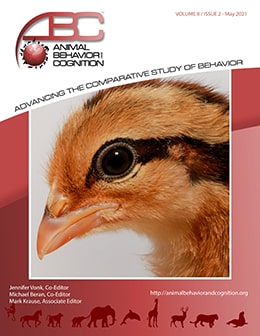Vol 8, Issue 2, May 2021
Methodological Challenges in the Assessment of Dogs' (Canis lupus familiaris) Susceptibility of the Ebbinghaus-Titchener Illusion Using the Spontaneous Choice Task
Citation
Becker, N., Prasad-Shreckengast, S, & Byosiere, S. E. (2021). Methodological challenges in the assessment of dogs’ (Canis lupus familiaris) susceptibility of the Ebbinghaus-Titchener illusion using the spontaneous choice task. Animal Behavior and Cognition, 8(2), 138-151. https://doi.org/10.26451/abc.08.02.04.2021
Abstract
Visual illusions represent an innovative method to investigate animal visual perception. One well known geometric illusion is the Ebbinghaus-Titchener illusion, which consists of two identically sized target circles with one surrounded by large inducer circles and the other surrounded by small inducer circles. Humans are susceptible to this illusion, underestimating the size of the target circle surrounded by larger inducers and overestimating the size of the target circle surrounded by smaller inducers. In the present study, we investigated whether pet dogs (Canis lupus familiaris) perceive the Ebbinghaus-Titchener illusion in a spontaneous choice task by adapting and replicating the methodology of Miletto Petrazzini et al. (2017). Twenty-five pet dogs were presented with two stimuli in which a food reward was embedded. Each subject participated in 18 total trials, 12 size discrimination control trials (where one food reward was larger than the other) and six illusion trials (where identically sized food rewards were presented). Dogs, as a group, failed to demonstrate a significant preference for the larger food reward in control trials, and demonstrated null susceptibility, performing at chance, in the illusion trials. The chance performance on controls prevents further interpretation regarding canine illusion susceptibility; however, it invokes a discussion regarding the methodological challenges associated with conducting spontaneous-choice tasks. In an attempt to provide guidance for future research, we provide a review of canine illusion susceptibility to the Ebbinghaus-Titchener illusion and detailed recommendations to help mitigate extraneous factors to help further research of animal illusion susceptibility.
Keywords
Canine cognition, Spontaneous choice task, Visual illusions, Visual perception, Ebbinghaus-Titchener illusion
